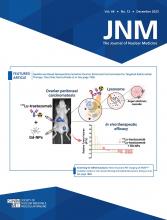Iodine-refractory thyroid cancer remains a major therapeutic challenge. Beyond tyrosine kinase inhibitors, other therapies that have been explored include tropomyosin kinase inhibitors, redifferentiation attempts, and peptide receptor radionuclide therapy targeting somatostatin receptors (SSTRs).
We report the case of a 58-y-old man with a history of papillary thyroid carcinoma. After initial surgery and ablative radioiodine therapy 10 y previously, no further follow-up had been performed. At the time of presentation, the serum thyroglobulin level was elevated to 6,600 ng/mL (thyroid-stimulating hormone, 1.15 mU/L). Radioiodine whole-body scintigraphy after administration of 3.7 GBq of 131I demonstrated only minimal iodine uptake in the neck region (Fig. 1A). Additional [18F]FDG PET/CT revealed extensive local recurrence and multiple lymph nodes, as well as bilateral lung and pleural metastases (Fig. 1B). A biopsy of the cervical lesion confirmed a nonpapillary tumor most consistent with oncocytic carcinoma (Hürthle cell carcinoma). Immunohistochemistry showed intense but heterogeneous membranous SSTR expression in more than 50% of tumor cells (immunoreactive score, 9; Fig. 1C).
(A and B) Whole-body 131I scintigraphy (A) and maximum-intensity projections of [18F]FDG, [68Ga]Ga-DOTATOC, and [68Ga]Ga-SSO120 (B) showing tumor manifestations with local recurrence (white arrow) and lung metastasis in the right lower lobe (asterisk). Incidental finding of a meningioma in [68Ga]Ga-SSO120 PET/CT (black arrow). (C) Immunohistochemical staining of SS expression in local recurrence.
To evaluate the possibility of SSTR-directed peptide receptor radionuclide therapy as an alternative to initiating tyrosine kinase inhibition, [68Ga]Ga-DOTATOC PET/CT was performed (1,2) and showed moderate to intense tracer uptake in all tumor manifestations (B). For further evaluation, the patient was offered PET/CT imaging with the SSTR antagonist [68Ga]Ga-SSO120 (international nonproprietary name, satoreotide trizoxetan, also known as NODAGA-JR11, OPS202, and IPN01070) (163 MBq, imaging 1 h after injection), yielding better visualization of all lesions (Fig. 1B). An increased SUVmax was particularly observed in lung and pleural metastases (e.g., SUVmax, 10.1 for [68Ga]Ga-SSO120 vs. 4.4 for [68Ga]Ga-DOTATOC in a lung metastasis in the right lower lobe) and in the local tumor recurrence (SUVmax, 39.0 for [68Ga]Ga-SSO120 vs. 30.9 for [68Ga]Ga-DOTATOC). On the basis of these findings, the patient was deemed eligible for peptide receptor radionuclide therapy. Given the greater number of binding sites and longer residence time on the cell surface, SSTR antagonists may be a viable option in diagnosis and therapy for many SSTR-positive tumor entities, such as differentiated and medullary thyroid carcinoma or small cell lung cancer (3,4).
DISCLOSURE
No potential conflict of interest relevant to this article was reported.
Footnotes
Published online Jun. 15, 2023.
- © 2023 by the Society of Nuclear Medicine and Molecular Imaging.
REFERENCES
- Received for publication February 26, 2023.
- Revision received May 1, 2023.








